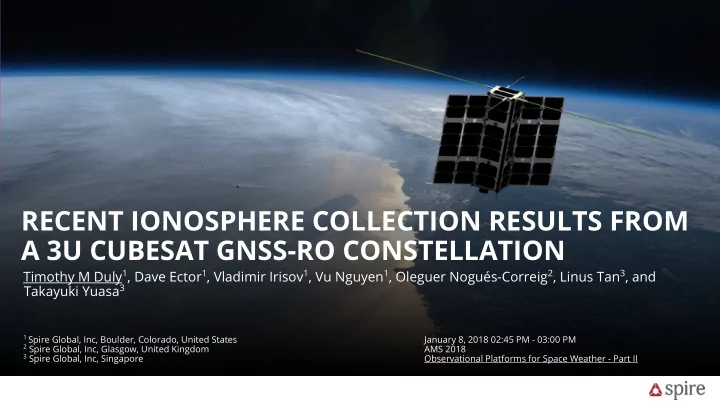

RECENT IONOSPHERE COLLECTION RESULTS FROM A 3U CUBESAT GNSS-RO CONSTELLATION Timothy M Duly 1 , Dave Ector 1 , Vladimir Irisov 1 , Vu Nguyen 1 , Oleguer Nogués-Correig 2 , Linus Tan 3 , and Takayuki Yuasa 3 1 Spire Global, Inc, Boulder, Colorado, United States January 8, 2018 02:45 PM - 03:00 PM 2 Spire Global, Inc, Glasgow, United Kingdom AMS 2018 3 Spire Global, Inc, Singapore Observational Platforms for Space Weather - Part II 1
SPIRE GLOBAL, INC. • Building the most advanced, constantly refreshed 3U CubeSat • 50+ CubeSats launched • Manufacturing up to 2 satellites per week • 4 months from design to launch • 26+ ground stations globally ensures low latency • Provide rapidly refreshed data: AIS, ADS-B ( soon ), and GNSS Radio Occultation (RO) 2
RADIO OCCULTATION (RO) RO is a robust and highly accurate technique for the remote sensing of GPS Sats Earth's neutral and plasma for POD atmosphere GPS α p LEO p Earth Atmosphere Ionosphere Comparison against the Global Forecast System See talk: "6A.1: Atmospheric Radio Occultation Observation (GFS) numerical weather from Spire CubeSat Nanosatellites" by V. Irisov on Thurs , model Jan 11 at 1:30pm in the " Atmospheric Soundings from Satellites" Session , Room 19AB (ACC) 3
REMOTE SENSING THE IONOSPHERE Dual frequency GNSS receiver is • Receive "POD TEC" data also capable of ionospheric remote from multiple dual sensing frequency GNSS links - Total electron content (TEC) from overhead GNSS links - Scintillation indices (S 4 and σ Φ ) - [ future ] Ionospheric occultations → electron density profiles Access to RO data (both neutral and plasma) are available via Spire's RO API (requires authentication) 4
REMOTE SENSING THE IONOSPHERE (Bias corrected) TEC generally follows IRI, an ionospheric climatological model LEO track approximates ionospheric sampling region Note: 1 TEC "Unit" (TECU) = 10 16 electrons/m 2 5
EXAMPLE COVERAGE (~3 HOURS) ~2 orbits provide diverse, global coverage of ionospheric region from one CubeSat Again, LEO track approximates ionospheric sampling region 6
THE GREAT AMERICAN SOLAR ECLIPSE approx eclipse path Decrease in TEC due to Eclipse? Constantly refreshed, global coverage provides unique opportunity to investigate ionospheric events 7
SPORADIC E LAYERS • Occultation data may also measure ionospheric Sporadic E layers - Observations of △ TEC and SNR fluctuations at ~110 km, indicative of E s - Similar to published data (signal strength) from GPS-CHAMP Wu et al (2005), Sporadic E morphology from GPS-CHAMP radio occultation , JGR (link) 8
OCCULTATION LOCATIONS Locations of RO atmospheric profiles With slight adjustments to firmware and ground processing, these locations could also represent electron density profiles 9
BY THE NUMBERS: DECEMBER 2017 • RO Ground Processing team maintains an extensive database of processing results (both RO profiles and December 2017 ionospheric results) - December 2017 saw ramp up in Number of TEC data points 3,136,691 RO Production - Mainly from ~3 hour daily Number of TEC "arcs" 2,122 collections from 1 or 2 CubeSats Number of scintillation data points 78,246 • Continue steadily increasing production numbers in 2018, (e.g., 500 profiles/day in Jan.) 10
OUTLOOK Spire is building a large (>100) • constellation of satellites to collect atmospheric and ionospheric data using RO for weather and space weather forecasting improvements Advance ionosphere processing: • electron density profiles, Sporadic E layers, etc. Upcoming: • - 6 months: 3,000 profiles/day Spire CubeSats awaiting deployment from the Cygnus resupply module - 12 months: 8,000 profiles/day (Credit: NASA Astronaut Randy Bresnik, @AstroKomrade) More info: https://spire.com/data/weather/ 11
For any questions, please contact: Timothy M. Duly timothy.duly@spire.com 1050 Walnut, Suite 402, Boulder, CO 80302 USA 12
Recommend
More recommend